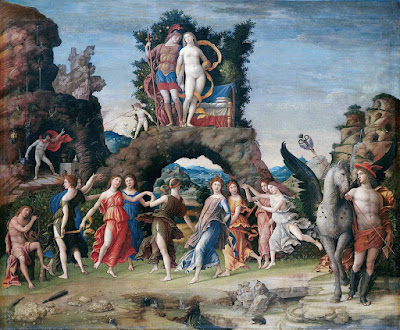 |
| Andrea Mantegna Mars and Venus, called Parnassus ca. 1496-97 tempera and oil on canvas Musée du Louvre |
 |
| Andrea Mantegna Mars and Venus, called Parnassus (Mars and Venus) ca. 1496-97 tempera and oil on canvas Musée du Louvre |
 |
| Andrea Mantegna Mars and Venus, called Parnassus (Vulcan) ca. 1496-97 tempera and oil on canvas Musée du Louvre |
 |
| Andrea Mantegna Mars and Venus, called Parnassus (Orpheus and the Muses) ca. 1496-97 tempera and oil on canvas Musée du Louvre |
The Studiolo of Isabella d'Este
This picture, along with another Mantegna also in the Louvre today, Minerva expelling the Vices from the Garden of Virtue, and a third, The Realm of King Comus, which the artist undoubtedly began and which Lorenzo Costa finished, along with an Allegory belonging to the same group, as also a Combat of Love and Chastity by Perugino and two Allegories of Correggio, were commissioned by Isabella d'Este to hang in a small meditation chamber for which she specified the themes. A little more than a century later, the grouping was reassembled in the château of the duc de Richelieu.
In an inventory of 1562 can be read the following description: "Mars, Venus, Vulcan, Orpheus and dancing Nymphs"
The Mythological Troop
Atop an arch framing a distant landscape stands Mars, helmeted and armoured, with Venus, nude, adorned with a sort of ribbon flourish that winds itself around one of her arms and one of her legs. Behind them, a bed – blue, white, red – before an orange tree and what appears to be a laurel. To the left of this couple, Cupid, his bow in one hand, uses the other to aim a long blow-pipe at the genitals of Vulcan, the legitimate husband of Venus. Vulcan, at his forge within Mount Etna working the volcanic rocks, his red cape billowing in the hot gusts from the furnace, menaces the adulterous couple with one hand and clutches in the other a gathering of the metal strands he is weaving into the net with which he intends to imprison them.
In the foreground are grouped the nine muses. At far right, dancing most passionately, is Terpsichore; at far left, the muse looking away from the others must be Clio; behind her, lifting arms to the sky, is likely the muse Urania. One could likewise surmise the names of them all. Orpheus, with his lyre, plays the role of Apollo, of whom he may be regarded as an incarnation.
 |
| Andrea Mantegna Mars and Venus, called Parnassus (Mercury with Pegasus) ca. 1496-97 tempera and oil on canvas Musée du Louvre |
 |
| Andrea Mantegna Mars and Venus, called Parnassus (foreground with small animals) ca. 1496-97 tempera and oil on canvas Musée du Louvre |
At far right, leaning against Pegasus (who paws the ground and who was credited with the ability to calm earthquakes), Mercury, with winged boots and cap, holds the greatly elongated staff of his caduceus. The soil beneath them is dry, with the remains of a spring, a few rocks, two rabbits emerging from their burrows, and a hedgehog.
Relationships
The arch alludes to a triumphal arch celebrating Mars and Venus. Their union is illegitimate, but destined to be consistently glorified throughout the centuries – even today Mars is a standard symbol of masculinity, as Venus is of the conventionally feminine. Her official marriage is with Vulcan, a ludicrous husband, old and feeble, who will nevertheless realize his vengeance. The blacksmith god, allied to craftsmen and trades, he embodies a contrast to Mars, the warrior, who consequently functions as the representative of nobility.
Each register relates to a social class: the nobility at the top, artisans in the middle, carrying forward the most ancient/fundamental discoveries, and artists along the bottom, promoting harmony among all tiers. There is an attempt to envision an era when Antiquity and Christianity are successfully united, where mythology is properly interpreted as the prefiguration of Revelation, and varying traditions speak to one another – including the dream of a world no longer torn apart by wars of religion. But just when the Turks, who had taken Constantinople, were being halted at Vienna, the confrontation was set to ignite between Rome and the Protestant sects.
– translated and adapted from Le Musée imaginaire de Michel Butor: 105 œuvres décisives de la peinture occidentale (Paris: Flammarion, 2019)